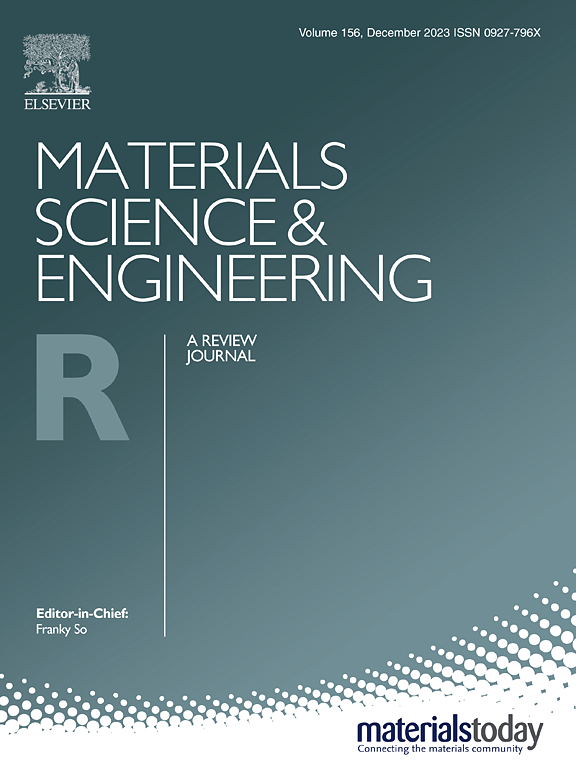基于经验方法的三元金属硫化物作为活性和选择性CO2还原电催化剂的探索分析
IF 31.6
1区 材料科学
Q1 MATERIALS SCIENCE, MULTIDISCIPLINARY
引用次数: 0
摘要
在寻求可持续的电化学二氧化碳还原反应(CO2RR)策略的过程中,开发高效、选择性的电催化剂仍然是一个重大挑战。金属硫化物提供了多种类型的吸附位点,这为克服传统催化剂(包括金属和合金)的缺点开辟了一条有希望的途径。由于研究金属硫化物作为CO2RR电催化剂的趋势的参考文献和讨论有限,在这里我们开发了一个不那么繁琐的经验工作流程。该方法的要点在于从实验数据中直接学习,并且不强制使用高通量实验工具。利用工作流程,我们的目标是澄清我们应该关注的性质,以预测和进一步获得最佳的电催化剂,在这个探索的早期阶段。该方法将实验数据的仔细分析与材料信息学相结合,利用密度泛函理论(DFT)计算和机器学习(ML)。在案例研究中,我们特别针对合成气一氧化碳(CO)生产的三元金属硫化物选择性。通过使用在18个样本数据集上训练的高维回归ML模型,我们的分析强调了将原子组成以外的晶体结构作为催化剂设计策略的重要性。我们发现,具有六方晶格体系和含有Zn/In/Cd阳离子的三元金属硫化物是co选择性电催化剂的最佳选择。我们的研究提供了探索未知材料的见解,以实现可持续的CO2RR,并具有适应各种应用领域的多功能和无负担的工作流程。本文章由计算机程序翻译,如有差异,请以英文原文为准。
An empirical approach-based analysis for the exploration of ternary metal sulfide as an active and selective CO2 reduction electrocatalyst
In the quest for sustainable electrochemical carbon dioxide reduction reaction (CO2RR) strategies, developing efficient and selective electrocatalysts remains a paramount challenge. Metal sulfides offer diverse types of adsorption sites, leading to a promising avenue to overcome the drawbacks of conventional catalysts, including metals and alloys. Since there are limited references and discussions to study the trend of metal sulfide as a CO2RR electrocatalyst, here we developed a less burdensome empirical workflow. The point of the methodology lies in the straightforward learning from experimental data, and the utilization of high-throughput experimental tools is not compulsory. Using the workflow, we aim to clarify what properties we should be concerned about to predict and further obtain optimal electrocatalysts in this early stage of exploration. The methodology integrates a careful analysis of experimental data with material informatics, leveraging density functional theory (DFT) calculations and machine learning (ML). For the case study, we specifically target the ternary metal sulfide selective for syngas carbon monoxide (CO) production. By employing high-dimensional regression ML models trained on a dataset of 18 samples, our analysis underlines the importance of considering crystal structure beyond atomic composition as the catalyst design strategy. We identify that ternary metal sulfides with hexagonal lattice systems and containing cations among Zn/In/Cd are optimal for CO-selective electrocatalysts. Our study offers insights into exploring uncharted materials for a sustainable CO2RR with a versatile and burdenless workflow adaptable to various application fields.
求助全文
通过发布文献求助,成功后即可免费获取论文全文。
去求助
来源期刊

Materials Science and Engineering: R: Reports
工程技术-材料科学:综合
CiteScore
60.50
自引率
0.30%
发文量
19
审稿时长
34 days
期刊介绍:
Materials Science & Engineering R: Reports is a journal that covers a wide range of topics in the field of materials science and engineering. It publishes both experimental and theoretical research papers, providing background information and critical assessments on various topics. The journal aims to publish high-quality and novel research papers and reviews.
The subject areas covered by the journal include Materials Science (General), Electronic Materials, Optical Materials, and Magnetic Materials. In addition to regular issues, the journal also publishes special issues on key themes in the field of materials science, including Energy Materials, Materials for Health, Materials Discovery, Innovation for High Value Manufacturing, and Sustainable Materials development.
 求助内容:
求助内容: 应助结果提醒方式:
应助结果提醒方式:


